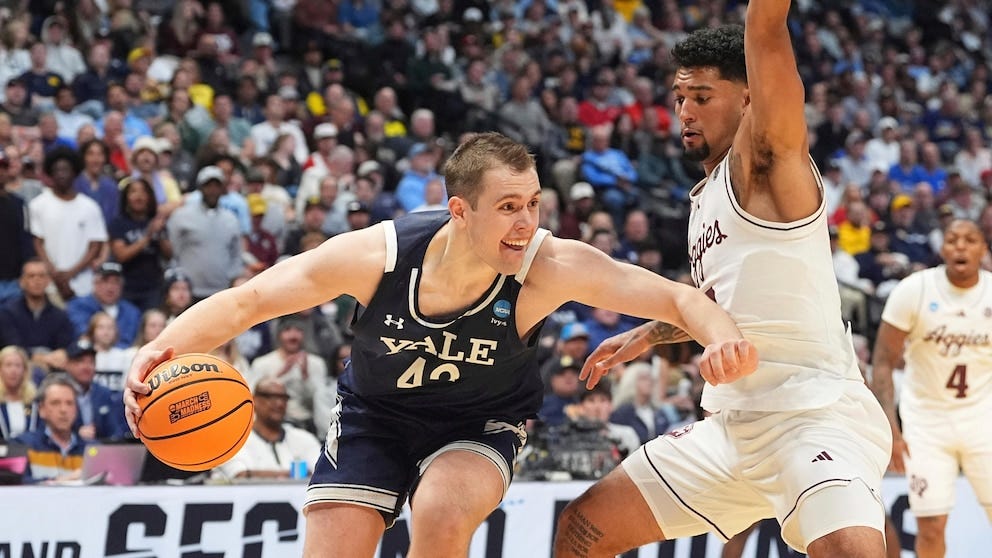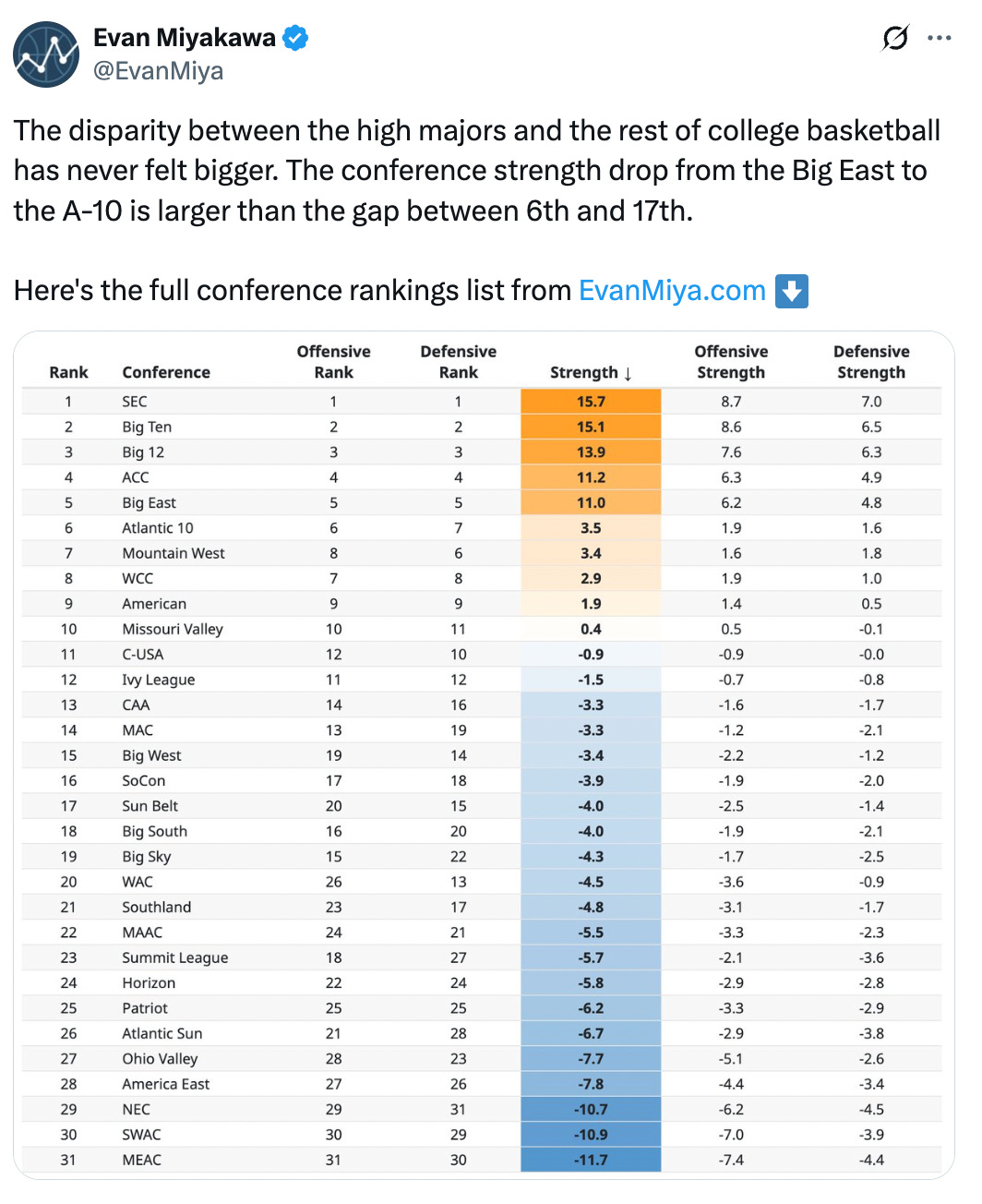There's never been a worse time to be a college basketball mid-major
And other leftover thoughts on the season to come
We have always been a transfer portal and NIL extremist. Both are good things. Players generating this much revenue for schools, leagues and TV networks should have fundamentally the same rights as coaches: Go where you can earn the most money, and be able to do it right away.
They are not perfect systems, though. Of course not. No one has ever argued that, far as we can tell, and no reasonable person would. They’re like the NCAA’s NET rankings: Flawed, prone to negative downstream impacts, but nonetheless vast improvements on what came before. Progress is progress. Don’t let the perfect be the enemy of the good — or at least the better.
From the outset, it was clear that the immediate eligibility and the NIL gold-rush were going to accelerate the gap between college basketball haves and have-nots. It was predictable. This gap has always existed, and will always exist, because that’s just how things work. This is not a professional league with equally distributed revenues and a tightly managed salary cap. Before, big schools spent fortunes on coaches, facilities and amenities. They would apply those same advantages to a much more direct form of player recruitment and retention. Mid-major schools with FloSports rights deals would obviously struggle to keep pace.
With all that said: We didn’t think it would get this bad this fast.
You could see this in the almost entirely upset-free 2025 NCAA Tournament. You can see it in Evan’s and Ken Pomeroy’s team rankings, too. Forget the top 25; the preseason top 80 is almost entirely dominated by high-major teams. The exceptions are expected: Gonzaga and Saint Mary’s, the top of the A10 (places like Dayton, VCU, SLU, and George Washington, where real investment is happening), Memphis, Grand Canyon (a massive for-profit school with unlimited cash), most of which are only nominally “mid-majors.” And that’s about it.
There are basically none of the hyped, veteran, coming-off-a-Sweet-16-run-and-brought-everyone-back mid-majors here. It used to feel like — without looking back at the numbers, granted — there was one of those hovering around the top 25 every season. Now they’re just gone.
For example: Drake. Once upon a time, Drake would have been that team. The Bulldogs finished 31-3 with a brilliant first-year head coach and one of the best guards in the sport — a senior national player of the year candidate. They would have been a summer prediction favorite. But it’s 2025, so everything happened faster, and for understandable financial reasons: Ben McCollum left after year one, Bennett Stirtz went with him, everybody is getting paid considerably more (even if Stirtz could have found a bigger check on the open market if he wanted to) and everybody is now safely ensconced in one of the richest leagues in college athletics.
Drake is ranked 123rd in the preseason KenPom rankings. Many such cases.
Again: This was always going to happen. Everyone priced it in. It’s also not just down to transfers/NIL: High-major leagues are also just getting bigger, hoovering up all the programs they can, and thus indirectly forcing more teams up the ladder. But the speed and degree of the change is disconcerting. We always thought there was a chance that savvy mid-major coaches would use the portal in the opposite direction — picking off talented but unused reserves from high-major coaches who got greedy (or just missed on an evaluation) in recruiting. That has happened anecdotally, sure. There are mid-majors doing lots of interesting recruiting work, and coaches trying to combine analytical insights with a few more NIL dollars here and there. Market inefficiencies are out there. But it’s all marginal. The trend line is clear. The big boys are drinking the mid-majors’ milkshake.
We have no idea how to stop this, even if you could convince people to try. Maybe revenue sharing will help? Seems like wishful thinking. This just appears to be where we are now — which is where we were for most of college basketball’s existence, granted, but more so, and worse.
For more on this trend, and a ton of other really detailed thoughts on mid-major teams across the Division I spectrum, check out this episode of Basket Under Review with highly attuned mid-major expert Rocco Miller.
This is (sort of) the final in a series of previews we’ve written about the 2025-26 season. The previous editions covered every high-major conference in detail; this is a collection of other thoughts we’ve had since we recorded that pod with Rocco, mostly about non-power conference teams and leagues, randomly ordered.
Also: We’ll be running live chats throughout the season, per usual. They were a huge hit last year, especially throughout the tourney. Our first thread for opening day/week is already up. Stop by and chop it up with Buzzer’s fantastic, tight-knit community as we revel in college basketball’s glorious return. See you there!
Gonzaga fans are right to be excited
Nominally, Buzzer tries to cover all of Division I. In practice, it can be tough. This newsletter is a one-writer deal. There are 365 D1 teams. Most of these, respectfully, are not going to draw a ton of consistent reader interest. Choices must be made. One of the hardest parts of the job, once the season gets going, is making sure that you at are least attempting to be as up to speed on as many teams as you possibly can. Nothing annoys die-hard fans — the kinds of people who watch every press conference on YouTube, read every offseason injury update, and spend hours a day chatting with other fans — more than when they read something about their team that feels casual or poorly informed. You may not nail it all the time, but you have to at least show you’ve done the work.
And even then, fundamentally, fans are often going to know more.
Keep reading with a 7-day free trial
Subscribe to Buzzer by Eamonn Brennan to keep reading this post and get 7 days of free access to the full post archives.



